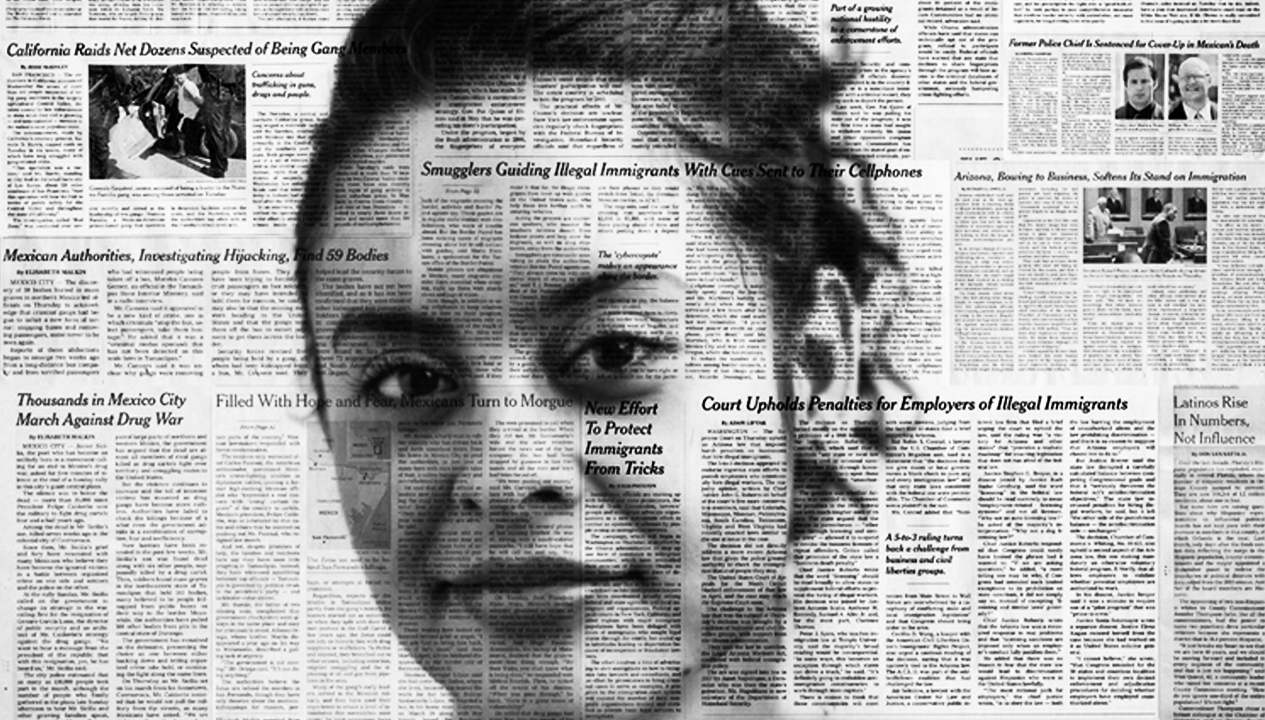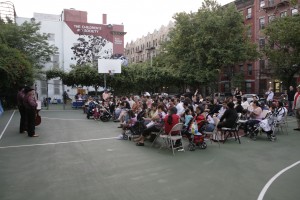Gala Narezo (Photography and Imaging ’01) is also a graduate of Yale University. She started her career in television and film production before focusing on photography. Her projects have been exhibited internationally. Her book of photographs, “Locales,” documenting quickly disappearing local shops in the gentrifying neighborhood of Colonia Roma, in Mexico City, was published by Artes de Mexico. In her photography and collaborations Gala specializes in creating platforms for social issues using design thinking, and storytelling. Currently Gala works as a multidisciplinary art director. Her recent projects have included social awareness campaigns, urban interventions and curricula development for topics as varied as immigration, sustainability and mindful education.

COLLABORATING WITH DESIGNMATTERS
 When I graduated from Art Center in 2001, I had just recently been introduced to Mariana Amatullo (by Richard Koshalek) who was launching Designmatters. Since my plan upon graduation was to live between my two homes in Mexico City and New York City, Mariana suggested that I help by becoming a liaison with the United Nations. Designmatters had recently been awarded NGO status with UN affiliation, (Art Center continues to be the only design school with this status,) and since the UN headquarters is in NYC it was useful for Designmatters to have a local presence. The liaison position lead to many fruitful partnerships. I participated in the planning committee for the UN NGO/DPI Conference for several years, served on the executive committee and helped to identify and develop content for a series of classes offered by Designmatters. The classes included a campaign for the Millennium Development Goals, a contemporized view of the Human Rights Campaign, a collaboration between Mexican and American students addressing Disarmament amongst others. It had never been so clear that artists, designers and communicators were much needed and had a role to play in solving the world’s biggest challenges.
When I graduated from Art Center in 2001, I had just recently been introduced to Mariana Amatullo (by Richard Koshalek) who was launching Designmatters. Since my plan upon graduation was to live between my two homes in Mexico City and New York City, Mariana suggested that I help by becoming a liaison with the United Nations. Designmatters had recently been awarded NGO status with UN affiliation, (Art Center continues to be the only design school with this status,) and since the UN headquarters is in NYC it was useful for Designmatters to have a local presence. The liaison position lead to many fruitful partnerships. I participated in the planning committee for the UN NGO/DPI Conference for several years, served on the executive committee and helped to identify and develop content for a series of classes offered by Designmatters. The classes included a campaign for the Millennium Development Goals, a contemporized view of the Human Rights Campaign, a collaboration between Mexican and American students addressing Disarmament amongst others. It had never been so clear that artists, designers and communicators were much needed and had a role to play in solving the world’s biggest challenges.
WHAT MOVES YOU?
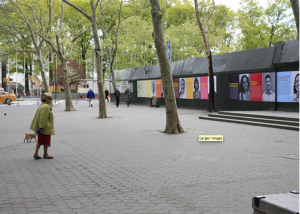
Global Voices, a “what moves you?” traveling exhibit displayed at Dag Hammarskjold Park across the street from the United Nations.
The relationships that I developed with individuals and NGO’s while working on the planning committee of the yearly UN DPI/NGO Conference (one of Designmatters first formal engagement with the UN) lead to many interesting projects and lasting relationships. In 2006 while serving on the youth committee I met Shamina de Gonzaga, now director of WCPUN, who would become my collaborator and the co-founder of what moves you? an organization that produces educational public art and media exploring the relevance of global and social issues in people’s lives. what moves you? focuses on generating innovative ways to tell stories, travel unheard voices and convene multi-sector dialogues. what moves you? has had installations and workshops presented at the United Nations, the Aspen Institute as well as many academic and cultural institutions.
Over the last six years, Shamina and I have worked together on many projects including a traveling exhibit on the Millennium Development Goals, Centerpoint Now, a journal that convenes diverse voices on timely international issues, a film series on immigration and MEXUS an ongoing series on Mexican/US immigration issues.
INDOCUMENTALES/UNDOCUMENTARIES: THE US/MEXICO INTERDEPENDENT FILM SERIES
Both New Yorkers of Mexican heritage, Shamina and I launched the MEXUS platform for inclusive dialogue on Mexico-U.S. relations in 2009, an educational campaign presenting the diverse backgrounds, experiences, and aspirations of the Mexican community in the United States. This in turn lead to the launching of Indocumentales/Undocumentaries:The US/Mexico Interdependent Film Series in 2010, presented by what moves you?, CLACS (the Center for Latin American and Caribbean Studies) at NYU and Cinema Tropical. This is a collaborative series designed to inform, inspire, and enable an open exchange of views on some of today’s most pressing immigration-related issues. In addition to showcasing documentary feature films by directors from both sides of the border, each screening is followed by an informal interactive discussion with special guests of diverse backgrounds, sectors and experience. Indocumentales explores the web of complicity, indifference, and economic interests involved in maintaining the status quo, in both U.S. and Mexican societies, and offers an opportunity for people to think about solutions. The Indocumentales film screenings and dialogues travels to diverse cultural, academic and community centers across the United States. Along the way, the Indocumentales on-line resource packet expands to include new offerings that add to our understanding of the issues, and help connect individuals and organizations working to address them.
PUBLIC PROJECT AT PRATT
In 2010, I began teaching Design Advocacy classes at Pratt Institute in the Graduate Communication Design Department with Jean Brennan and in 2011 we began an initiative called Public Project at Pratt. Public Project’s mission is to use design to create conversations in the public sphere while seeking to broaden the educational experience of students by organizing engagements with outside institutions, businesses and not-for-profit organizations. Centered around the themes of social practice, research, and entrepreneurship, students engage in opportunities to apply design to real world challenges. Public Project houses a publishing initiative to broadcast student research, critical writings, and formal design experiments to audiences beyond the Institute. The curriculum has centered around topics as diverse as maternal health, the city as a living ecosystem, transforming communities and immigration and identity curricula.
DESIGNING VOICE
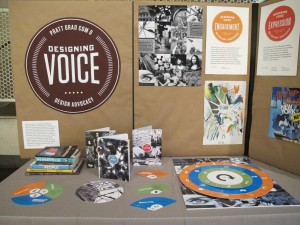 Designing Voice, resulted from a Pratt Institute and CLACS collaboration that started in the fall of 2012. New York City public school teachers who were part of an NYU residency at CLACS (the Center for Latin American and Caribbean Studies) were teamed with Pratt graduate students. The brief was for the students to develop innovated ways to assist the teachers with their lessons using design thinking methodologies and communication skills. This term long collaboration resulted in three projects that will be offered through the CLACS website titled Designing Voice. Designing Voice: Language is a workbook that allows identity exploration and reflection through the usage of multiple languages. The Designing Voice: Expression lesson presents a set of teaching tools to promote the use of student voice for creative expression and advocacy. Designing Voice: Engagement is an engaged-learning tool that encourages educators and students to creatively explore their culture in new ways while simultaneously improving academic competencies.
Designing Voice, resulted from a Pratt Institute and CLACS collaboration that started in the fall of 2012. New York City public school teachers who were part of an NYU residency at CLACS (the Center for Latin American and Caribbean Studies) were teamed with Pratt graduate students. The brief was for the students to develop innovated ways to assist the teachers with their lessons using design thinking methodologies and communication skills. This term long collaboration resulted in three projects that will be offered through the CLACS website titled Designing Voice. Designing Voice: Language is a workbook that allows identity exploration and reflection through the usage of multiple languages. The Designing Voice: Expression lesson presents a set of teaching tools to promote the use of student voice for creative expression and advocacy. Designing Voice: Engagement is an engaged-learning tool that encourages educators and students to creatively explore their culture in new ways while simultaneously improving academic competencies.
DESIGN THINKING/ACTIVISM/MINDFUL EDUCATION
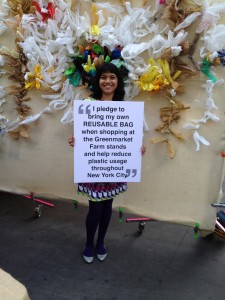
The Plastic Bag Mandala hosted by NYC at the Union Square Greenmarket is a participatory awareness campaign about plastic bags encouraging New Yorkers to consider laws limiting the use of plastic bags.
The belief that mindfulness is an essential component of social impact design led me to integrate transformational activism teachings into my undergraduate and graduate classes at Art Center College of Design and Pratt Institute. Based on the last twelve years in this field, I’m currently developing a program to teach a synthesis of art/design, social impact and mindful education to high school and elementary school students. These workshops and classes present the opportunity for students to apply synergistic problem solving methods to real world problems that impact their lives. Whenever possible the students are required to test out their solutions in a community. They are then encouraged to weigh the impact and consequences of their solutions while continuously reflecting on the process.
THE PLASTIC BAG MANDALA
The Plastic Bag Mandala started in Sept 2011 as a collaboration between a Design Advocacy class at Pratt Institute and an activism group at The Interdependence Project. The project began as a way to engage New Yorkers in conversation around plastic bag waste as the first stop on the way to change New York City legislation on this issue. The mandala began to take shape as a community action at the Union Square Greenmarket. Market goers were given the chance to exchange an old single-use plastic bag, for a new, re-usable bag. In one day, over six hundred people set an intention to reduce plastic consumption by signing a pledge to use re-usable Since then, the mandala has been invited and visited the market many times in addition to traveling to different locations. It has served as a template for continued action, and an embodied aspiration for a plastic-bag-free future. The mandala project has also offered upcycling workshops to young children at several schools. Currently being developed is an initiative to inspire New Yorkers to “reduce single use” and consider their “to go” consumption habits by creating a “To Go Bag” that allows you to be prepared with canteen and recyclable containers during your day.
21st CENTURY SUSTAINABILITY
The word on everyone’s lips these days is “sustainability” but what does it really mean? It is a confounding term that seems to mean everything and nothing. What we do know is that we need sustainable survival conditions for everyone. These days sustainability is not just about the environment. It includes social, economic and environmental well-being. Defining the parameters for sustainability is more complex. There are certain systems that we can clearly observe are no longer functional in the 21st century. Take for example our current consumption behaviors. Does it sound sustainable to use and dispose of 2 million plastic bags every five minutes and 28,000 barrels of oil every two minutes? How does one change such daunting statistics? If this is a system, a system of consumption, then how does one create or design a new and better one and get everyone to join?
Changing systems begins with the individual taking responsibility to notice what is going on around them. Noticing where systems exist and understanding how they function can give us the information we need to create new, more sustainable habits and patterns on a personal level and on a global scale. This is why I am enthusiastic about the “To Go Bag.” Maybe it won’t change the overall consumption patterns of New Yorkers but it might start people thinking about why they say yes to so many single use products every single day and what that daily impact really means. Empowered by ones capacity to be mindful this newfound awareness can lead to many bigger changes.
Small changes in habitual behaviors taken on by many become a systemic change. How things are done becomes how things used to be done and all of a sudden there is a new system, a new way of understanding a problem, a new outcome. If we want to be a part of a more sustainable world then we all must pay a little more attention to our personal behavior within our environment and our community. Doing this will allow us all to become systems designers and to make choices that will build a sustainable future.
For more information about Gala Narezo and her work, visit: galanarezo.com
